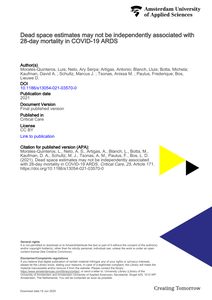BackgroundHigh-flow nasal oxygen (HFNO) is increasingly used in patients with acute hypoxemic respiratory failure. It is uncertain whether a broadened Berlin definition of acute respiratory distress syndrome (ARDS), in which ARDS can be diagnosed in patients who are not receiving ventilation, results in similar groups of patients receiving HFNO as in patients receiving ventilation.MethodsWe applied a broadened definition of ARDS in a multicenter, observational study in adult critically ill patients with acute hypoxemic respiratory failure due to coronavirus disease 2019 (COVID-19), wherein the requirement for a minimal level of 5 cm H2O PEEP with ventilation is replaced by a minimal level of airflow rate with HFNO, and compared baseline characteristics and outcomes between patients receiving HFNO and patients receiving ventilation. The primary endpoint was ICU mortality. We also compared outcomes in risk for death groups using the PaO2/FiO2 cutoffs as used successfully in the original definition of ARDS. Secondary endpoints were hospital mortality; mortality on days 28 and 90; need for ventilation within 7 days in patients that started with HFNO; the number of days free from HFNO or ventilation; and ICU and hospital length of stay.ResultsOf 728 included patients, 229 patients started with HFNO and 499 patients with ventilation. All patients fulfilled the broadened Berlin definition of ARDS. Patients receiving HFNO had lower disease severity scores and lower PaO2/FiO2 than patients receiving ventilation. ICU mortality was lower in receiving HFNO (22.7 vs 35.6%; p = 0.001). Using PaO2/FiO2 cutoffs for mild, moderate and severe arterial hypoxemia created groups with an ICU mortality of 16.7%, 22.0%, and 23.5% (p = 0.906) versus 19.1%, 37.9% and 41.4% (p = 0.002), in patients receiving HFNO versus patients receiving ventilation, respectively.ConclusionsUsing a broadened definition of ARDS may facilitate an earlier diagnosis of ARDS in patients receiving HFNO; however, ARDS patients receiving HFNO and ARDS patients receiving ventilation have distinct baseline characteristics and mortality rates.Trial registration: The study is registered at ClinicalTrials.gov (identifier NCT04719182).
MULTIFILE

BACKGROUND: Estimates for dead space ventilation have been shown to be independently associated with an increased risk of mortality in the acute respiratory distress syndrome and small case series of COVID-19-related ARDS.METHODS: Secondary analysis from the PRoVENT-COVID study. The PRoVENT-COVID is a national, multicenter, retrospective observational study done at 22 intensive care units in the Netherlands. Consecutive patients aged at least 18 years were eligible for participation if they had received invasive ventilation for COVID-19 at a participating ICU during the first month of the national outbreak in the Netherlands. The aim was to quantify the dynamics and determine the prognostic value of surrogate markers of wasted ventilation in patients with COVID-19-related ARDS.RESULTS: A total of 927 consecutive patients admitted with COVID-19-related ARDS were included in this study. Estimations of wasted ventilation such as the estimated dead space fraction (by Harris-Benedict and direct method) and ventilatory ratio were significantly higher in non-survivors than survivors at baseline and during the following days of mechanical ventilation (p < 0.001). The end-tidal-to-arterial PCO2 ratio was lower in non-survivors than in survivors (p < 0.001). As ARDS severity increased, mortality increased with successive tertiles of dead space fraction by Harris-Benedict and by direct estimation, and with an increase in the VR. The same trend was observed with decreased levels in the tertiles for the end-tidal-to-arterial PCO2 ratio. After adjustment for a base risk model that included chronic comorbidities and ventilation- and oxygenation-parameters, none of the dead space estimates measured at the start of ventilation or the following days were significantly associated with 28-day mortality.CONCLUSIONS: There is significant impairment of ventilation in the early course of COVID-19-related ARDS but quantification of this impairment does not add prognostic information when added to a baseline risk model.TRIAL REGISTRATION: ISRCTN04346342. Registered 15 April 2020. Retrospectively registered.
MULTIFILE

BACKGROUND: Increasing evidence indicates the potential benefits of restricted fluid management in critically ill patients. Evidence lacks on the optimal fluid management strategy for invasively ventilated COVID-19 patients. We hypothesized that the cumulative fluid balance would affect the successful liberation of invasive ventilation in COVID-19 patients with acute respiratory distress syndrome (ARDS).METHODS: We analyzed data from the multicenter observational 'PRactice of VENTilation in COVID-19 patients' study. Patients with confirmed COVID-19 and ARDS who required invasive ventilation during the first 3 months of the international outbreak (March 1, 2020, to June 2020) across 22 hospitals in the Netherlands were included. The primary outcome was successful liberation of invasive ventilation, modeled as a function of day 3 cumulative fluid balance using Cox proportional hazards models, using the crude and the adjusted association. Sensitivity analyses without missing data and modeling ARDS severity were performed.RESULTS: Among 650 patients, three groups were identified. Patients in the higher, intermediate, and lower groups had a median cumulative fluid balance of 1.98 L (1.27-7.72 L), 0.78 L (0.26-1.27 L), and - 0.35 L (- 6.52-0.26 L), respectively. Higher day 3 cumulative fluid balance was significantly associated with a lower probability of successful ventilation liberation (adjusted hazard ratio 0.86, 95% CI 0.77-0.95, P = 0.0047). Sensitivity analyses showed similar results.CONCLUSIONS: In a cohort of invasively ventilated patients with COVID-19 and ARDS, a higher cumulative fluid balance was associated with a longer ventilation duration, indicating that restricted fluid management in these patients may be beneficial. Trial registration Clinicaltrials.gov ( NCT04346342 ); Date of registration: April 15, 2020.
DOCUMENT
